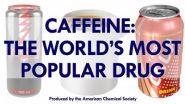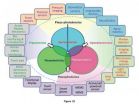(Press-News.org) WASHINGTON, April 14, 2014 — It seems there are new caffeine-infused products hitting the shelves every day. From energy drinks to gum and even jerky, our love affair with that little molecule shows no signs of slowing. In the American Chemical Society's (ACS') latest Reactions video, we look at the science behind the world's most popular drug, including why it keeps you awake and how much caffeine is too much. The video is available at http://youtu.be/YuJOhpNS0IY.
INFORMATION:
Subscribe to the series at Reactions YouTube, and follow us on Twitter @ACSreactions to be the first to see our latest videos.
The American Chemical Society is a nonprofit organization chartered by the U.S. Congress. With more than 161,000 members, ACS is the world's largest scientific society and a global leader in providing access to chemistry-related research through its multiple databases, peer-reviewed journals and scientific conferences. Its main offices are in Washington, D.C., and Columbus, Ohio.
To automatically receive news releases from the American Chemical Society, contact newsroom@acs.org.
Follow us: Twitter Facebook
The science of caffeine, the world's most popular drug (video)
2014-04-14
ELSE PRESS RELEASES FROM THIS DATE:
Study gives high marks to NC Pre-K program
2014-04-14
Scientists from UNC's Frank Porter Graham Child Development Institute have released their new study of NC Pre-K, the state's program to prepare four-year-olds for success in kindergarten. According to FPG's report, students enrolled in NC Pre-K show significant gains across all areas of learning.
"Children are progressing at an even greater rate during their participation in NC Pre-K than expected for normal developmental growth," said senior scientist Ellen Peisner-Feinberg, who leads the FPG team that has studied the program and provided it with recommendations for ...
Low birth weight, less breastfeeding create later health risks
2014-04-14
Lower weight babies and babies who aren't breastfed or not breastfed for long are at greater risk of developing chronic inflammation and related health problems later in life, according to a new study.
"There were good reasons to hypothesize that breastfeeding was important to influencing levels of inflammation in adulthood," says Thomas McDade (Northwestern University), a CIFAR (Canadian Institute for Advanced Research) Fellow in the Child & Brain Development program. "It changes the microbiome. It promotes development of the immune system. Children who are breastfed ...
Antibiotics alone are a successful treatment for uncomplicated acute appendicitis in kids
2014-04-14
Using antibiotics alone to treat children with uncomplicated acute appendicitis is a reasonable alternative to surgery that leads to less pain and fewer missed school days, according to a pilot study. The research, led by a team at Nationwide Children's Hospital and published online April 12 in the Journal of the American College of Surgeons, is the first prospective study on nonoperative management of acute appendicitis in pediatric patients in the United States.
Researchers enrolled 77 patients age 7 to 17 who were diagnosed with uncomplicated acute appendicitis by ...
Irrational health beliefs linked to skipping cardiac rehab sessions
2014-04-14
COLUMBUS, Ohio – Heart patients with beliefs about health that aren't based on medical evidence are more likely to skip sessions of cardiac rehabilitation, new research suggests.
In the Ohio State University study, a higher number of these beliefs – referred to as "irrational health beliefs" on a standard measure of these thoughts – was associated with lower adherence to a prescribed cardiac rehab program.
Among the irrational beliefs assessed: Doubting the preventive power of the flu vaccine or believing, based on family history alone, that it's safe to smoke cigarettes ...
Three new species of yellow-shouldered bats discovered in museum collections
2014-04-14
Scientists at Chicago's Field Museum and international collaborators have reconstructed the phylogeny and biological history for the Yellow-shouldered bats in the New World tropics, the region of the Earth surrounding the equator. In-depth analysis of mitochondrial and nuclear DNA sequences uncovered three species new to science, each having previously been confused with another species. Since 1960, when modern studies on this group began, Sturnira has grown from eight species to 22. The newest additions were described in a new study, published online in ZooKeys.
The ...
Ex vivo efficacy of C1s antibody as Complement inhibitor in cold agglutinin disease
2014-04-14
SOUTH SAN FRANCISCO, Calif.--True North Therapeutics, Inc., announced today a publication demonstrating that the company's C1s antibody prevents the destruction of human red blood cells exposed to plasma samples of patients with a type of autoimmune hemolytic anemia (AIHA). The article entitled "TNT003, an inhibitor of the serine protease C1s, prevents complement activation induced by cold agglutinin disease patient autoantibodies" was published on-line in the journal Blood earlier this month. TNT003 is the murine analog of True North's lead humanized monoclonal antibody ...
Neuroscientists: Brain activity may mark the beginning of memories
2014-04-14
By tracking brain activity when an animal stops to look around its environment, neuroscientists at the Johns Hopkins University believe they can mark the birth of a memory.
Using lab rats on a circular track, James Knierim, professor of neuroscience in the Zanvyl Krieger Mind/Brain Institute at Johns Hopkins, and a team of brain scientists noticed that the rats frequently paused to inspect their environment with head movements as they ran. The scientists found that this behavior activated a place cell in their brain, which helps
the animal construct a cognitive map, ...
Piezotronics and piezo-phototronics leading to unprecedented active electronics and optoelectronics
2014-04-14
New technologies for developing electronics and optoelectronics with tunable/adaptive functionalities and performance are critical to emerging applications in wearable technology, communication, pervasive computing, human-machine interfacing and biomedical diagnostics, in which the active and adaptive interactions between devices and stimuli from the ambient/host (e. g. human body) are essential. Mechanical stimuli are ubiquitous and abundant in the environment for interacting with or controlling these electronics/optoelectronics. This is, however, not facile to implement ...
Quantum manipulation: Filling the gap between quantum and classical world
2014-04-14
Quantum superposition is a fundamental and also intriguing property of the quantum world. Because of superposition, a quantum system can be in two different states simultaneously, like a cat that can be both "dead" and "alive" at the same time. However, this anti-intuitive phenomenon cannot be observed directly, because whenever a classical measuring tool touches a quantum system, it immediately collapse into a classical state. On the other hand, quantum superposition is also the core of quantum computer's enormous computational power. A quantum computer can easily break ...
New Commission study identifies Europe's top ICT hubs
2014-04-14
Wondering what makes an ICT hotspot? Take a look at Munich, London, Paris or smaller cities such as Darmstadt identified in a new EU Atlas of ICT hotspots. This atlas shows where digital technologies thrive and examines the factors contributing to this success.
Most of Europe's ICT activity takes place in 34 regions across 12 countries (listed in the Annex). Key ingredients to success included access to top Universities and research centres and funding opportunities such as venture capital.
European Commission Vice-President @NeelieKroesEU said: "This is proof that ...



